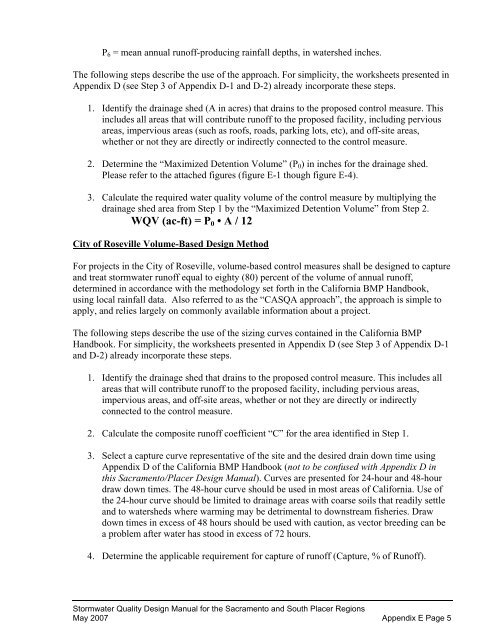Stormwater Quality Design Manual (May 2007) - City of Sacramento ...
Stormwater Quality Design Manual (May 2007) - City of Sacramento ...
Stormwater Quality Design Manual (May 2007) - City of Sacramento ...
- No tags were found...
You also want an ePaper? Increase the reach of your titles
YUMPU automatically turns print PDFs into web optimized ePapers that Google loves.
P 6 = mean annual run<strong>of</strong>f-producing rainfall depths, in watershed inches.The following steps describe the use <strong>of</strong> the approach. For simplicity, the worksheets presented inAppendix D (see Step 3 <strong>of</strong> Appendix D-1 and D-2) already incorporate these steps.1. Identify the drainage shed (A in acres) that drains to the proposed control measure. Thisincludes all areas that will contribute run<strong>of</strong>f to the proposed facility, including perviousareas, impervious areas (such as ro<strong>of</strong>s, roads, parking lots, etc), and <strong>of</strong>f-site areas,whether or not they are directly or indirectly connected to the control measure.2. Determine the “Maximized Detention Volume” (P 0 ) in inches for the drainage shed.Please refer to the attached figures (figure E-1 though figure E-4).3. Calculate the required water quality volume <strong>of</strong> the control measure by multiplying thedrainage shed area from Step 1 by the “Maximized Detention Volume” from Step 2.WQV (ac-ft) = P 0 • A / 12<strong>City</strong> <strong>of</strong> Roseville Volume-Based <strong>Design</strong> MethodFor projects in the <strong>City</strong> <strong>of</strong> Roseville, volume-based control measures shall be designed to captureand treat stormwater run<strong>of</strong>f equal to eighty (80) percent <strong>of</strong> the volume <strong>of</strong> annual run<strong>of</strong>f,determined in accordance with the methodology set forth in the California BMP Handbook,using local rainfall data. Also referred to as the “CASQA approach”, the approach is simple toapply, and relies largely on commonly available information about a project.The following steps describe the use <strong>of</strong> the sizing curves contained in the California BMPHandbook. For simplicity, the worksheets presented in Appendix D (see Step 3 <strong>of</strong> Appendix D-1and D-2) already incorporate these steps.1. Identify the drainage shed that drains to the proposed control measure. This includes allareas that will contribute run<strong>of</strong>f to the proposed facility, including pervious areas,impervious areas, and <strong>of</strong>f-site areas, whether or not they are directly or indirectlyconnected to the control measure.2. Calculate the composite run<strong>of</strong>f coefficient “C” for the area identified in Step 1.3. Select a capture curve representative <strong>of</strong> the site and the desired drain down time usingAppendix D <strong>of</strong> the California BMP Handbook (not to be confused with Appendix D inthis <strong>Sacramento</strong>/Placer <strong>Design</strong> <strong>Manual</strong>). Curves are presented for 24-hour and 48-hourdraw down times. The 48-hour curve should be used in most areas <strong>of</strong> California. Use <strong>of</strong>the 24-hour curve should be limited to drainage areas with coarse soils that readily settleand to watersheds where warming may be detrimental to downstream fisheries. Drawdown times in excess <strong>of</strong> 48 hours should be used with caution, as vector breeding can bea problem after water has stood in excess <strong>of</strong> 72 hours.4. Determine the applicable requirement for capture <strong>of</strong> run<strong>of</strong>f (Capture, % <strong>of</strong> Run<strong>of</strong>f).<strong>Stormwater</strong> <strong>Quality</strong> <strong>Design</strong> <strong>Manual</strong> for the <strong>Sacramento</strong> and South Placer Regions<strong>May</strong> <strong>2007</strong> Appendix E Page 5



